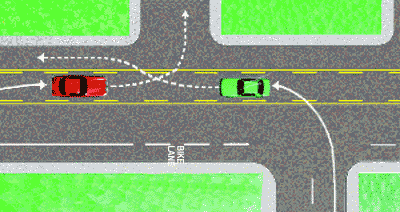
Some folks call the center two-way turn lane the “suicide” lane! That’s a little extreme — traffic engineers will tell you these lanes are actually pretty safe. But every day, you see people using them in ways that were never intended, and some of these actions are NOT safe. The lane I’m referring to is the one in the center of many streets and highways that both directions of traffic can use to make left turns.
I would bet that the laws governing the use of these two-way left turn lanes are hotly argued in many states; before you take ANY of the advice I offer in this article, it is essential you find out how the rules for use of this lane are written in your state, what is allowed and what isn’t. Also keep in mind that no matter how the laws are written, there can be differences in enforcement practices and interpretation, which will complicate things when you are trying to stay out of trouble. What one jurisdiction allows without a raised eyebrow, another might find totally inappropriate and issue a citation.
In my state of Arizona, the two-way left turn lane must be used for all turns made from the roadway. It is also legal to use it to stage a left turn into a roadway, from a parking lot or side street, for example. You may make a left turn into the center lane, then make a right lane change into the flow of traffic to complete the movement. It is NOT legal to use the lane for a rolling merge into that same traffic — our law states that you cannot drive in the lane unless you are making a left turn. Since the left turn is already completed at this point, it is illegal in my opinion to accelerate while trying to merge. This is the most controversial aspect of using these lanes, and you may find that different law enforcement agencies or judges in your area have opposing views on the correct use of these lanes.
You should not use this lane to pass through any intersections (remember that “intersection” can also be a side street with a major street), and you should never use the lane to pass other traffic. These are the most common errors, along with the natural tendency of drivers to make those rolling merges after making a left turn into a roadway. To make a left turn into the roadway correctly, you must stop once you’ve made the turn into the center two-way left turn lane. Then, visually clear the traffic over your shoulder and merge right into the left traffic lane when it is safe to do so.
Why Are They Called “Suicide” Lanes?
Having traffic moving in opposite directions using these lanes at the same time can be a stress-inducer. Normally, the low speeds involved keep conflicts at a minimum. Remember that even if the other guy was in the lane first, both directions of traffic still have the right to use it, and I have never seen or heard of any specific right-of-way rules for their use. The only sane way to deal with multiple vehicles using the lane at the same time is to be unfailingly courteous and try to fit into the lane in a way that is a win/win for all participants. It’s no place for road-hoggery!
Key Points to Remember
- Know Your State’s Laws:
- Understand the specific traffic laws in your state regarding the use of two-way left turn lanes, as rules and enforcement can vary.
- Proper Use:
- Use these lanes only for making left turns from or onto the roadway. Avoid using them for rolling merges or passing through intersections.
- Stop and Merge Safely:
- After making a left turn into the lane, stop and ensure the traffic is clear before merging into the flow of traffic. This reduces the risk of collisions.
- Avoid Common Mistakes:
- Do not use the lane for passing other vehicles or driving through intersections. These actions can lead to dangerous situations and potential citations.
- Be Courteous:
- When multiple vehicles are using the lane simultaneously, exercise courtesy and patience to ensure everyone’s safety.
By following these guidelines and being aware of the rules in your area, you can use the center two-way turn lanes safely and effectively, reducing the risk of accidents and making the roads safer for everyone.
